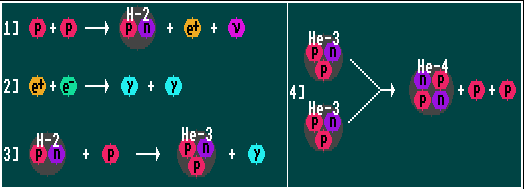

1) The first step is the proton-proton fusion reaction, involving the transformation of a proton into a neutron producing deuterium plus a positron and a 0.42MeV (or less) electron neutrino, a form of inverse beta decay. Many millions of protons per second meet head-on in the core, but only very few are sufficiently hot to overcome coulombic repulsion between like charges and fuse. The improbability of this reaction confers upon the sun its longevity, it is only halfway through its lifetime of 1011 years.
2) The positron soon annihilates with an electron to produce 2 gamma rays.
3) Within a second the deuterium is consumed producing helium-3.
The high probability of this reaction ensures that stars are without deuterium.
4) Within a million years two helium-3 nuclei fuse producing helium-4.
The net reaction being: 4p ![]() He-4 +
He-4 + ![]() 's + 2
's + 2![]() , yielding 25MeV, the reaction rate being proportional to T4 (the fourth power of the temperature). 600 Megatons of hydrogen are converted into helium each second. The flux of solar neutrinos is 1.8×1038 /sec; 65×109 /cm2/sec upon the Earth, which pass unhindered straight from the suns centre. Because of innumerable collisions, the light, however, takes 170,000 years to travel from the core of the sun to the suns surface, but only 8 minutes more to reach Earth.
, yielding 25MeV, the reaction rate being proportional to T4 (the fourth power of the temperature). 600 Megatons of hydrogen are converted into helium each second. The flux of solar neutrinos is 1.8×1038 /sec; 65×109 /cm2/sec upon the Earth, which pass unhindered straight from the suns centre. Because of innumerable collisions, the light, however, takes 170,000 years to travel from the core of the sun to the suns surface, but only 8 minutes more to reach Earth.
The above diagram is summarised below:
| 1) p + p | |
| 2) e+ + e+ | |
| 3) H-2 + p | |
| 4) He-3 + He-3 |
![]()